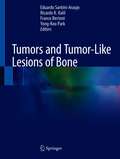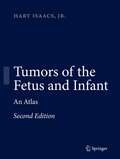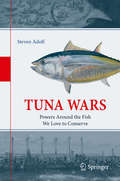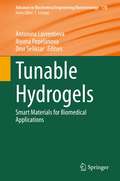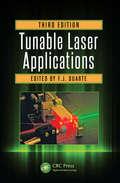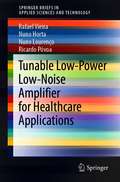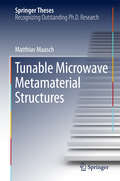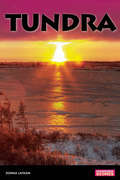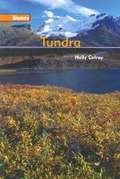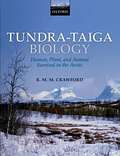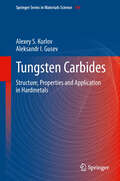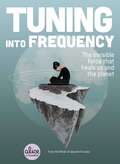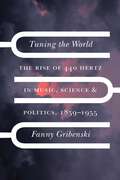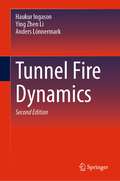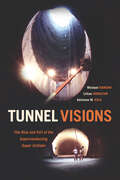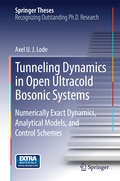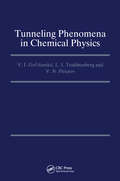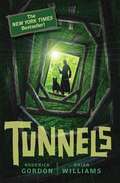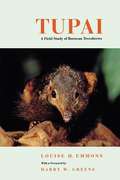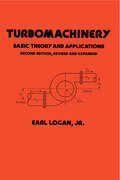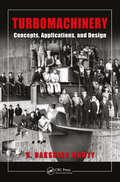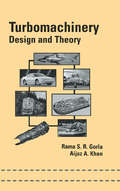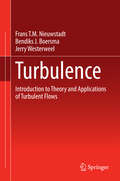- Table View
- List View
Tumors and Tumor-Like Lesions of Bone: For Surgical Pathologists, Orthopedic Surgeons And Radiologists
by Eduardo Santini-Araujo Ricardo K. Kalil Franco Bertoni Yong-Koo ParkThis updated second edition of a successful book provides essential, internationally applicable information in the area of bone and joint pathology with emphasis on practical diagnostic aspects, including many illustrations: roentgenograms, CT-scans, MRI, scintigraphies, as well as pictures of gross surgical specimens and microphotographs, immunohistochemical reactions and genomics. Information on histopathological and molecular diagnosis, and basic therapeutic guidelines are provided. This book offers generous coverage of epidemiology, clinical features, radiology, pathology, differential diagnosis, prognosis and treatment, not only for common lesions, but also for those less frequently encountered, including lesions of joints. The content is arranged based on the World Health Organization’s Consensus Classification, with the addition of other lesions not included therein. Tumors and Tumor-Like Lesions of Bone provides day-to-day assistance to general and specialized surgical pathologists, radiologists, orthopedic, head and neck and dental surgeons, oncologists and rheumatologists.
Tumors of the Fetus and Infant
by Hart IsaacsOver the past two decades, the remarkable advances in imaging techniques, such as ultrasound and fast or ultra-fast MRI, have led to the diagnosis of an increasing number of tumors at the prenatal stage. This revised, abundantly illustrated second edition of Tumors of the Fetus and Infant: An Atlas presents an up-to-date account of the clinical and pathological features of neoplastic disease and tumor-like conditions in the fetus, neonate, and infant and discusses major tumor studies and cases from throughout the world. The full range of tumors is covered, with each chapter reviewing the incidence, clinical findings, cytogenetics, pathology, radiology, treatment, and prognosis. The goal is to enable pathologists and clinicians to gain a clear understanding of these lesions so that a correct diagnosis can be achieved and appropriate treatment, initiated.
Tuna Wars: Powers Around the Fish We Love to Conserve
by Steven AdolfHistorically, whenever tuna was hauled ashore, the sounds of battle were never far away. ‘Tuna Wars’ tells the untold story of the power struggles emerging around tuna, from the distant past to your present-day dinner table.In the ancient past, the giant tuna was the first fish to become the basis of a large-scale industry and a ‘global’ trade that created fortunes: Hannibal was able to finance his elephant campaign on Rome thanks to tuna. From the Middle Ages on, a tuna fishing monopoly on Spain’s southern coast allowed the nobility to completely dominate the area and even lead the ‘invincible’ Armada. When the markets for tuna increased exponentially thanks to technical advances, tuna eventually became a billion-dollar business and one of the most-consumed fish species worldwide.But this massive expansion came at a price. An 18th century monk in Madrid was the first to warn that tuna fisheries needed to be run sustainably for the sake of future generations. And the issue of sustainability would go on to become a game-changer in the modern tuna wars, characterized by new alliances and partnerships, hybrid warfare and commercial power struggles. In addition to accompanying you through the history of tuna and sharing insights into fisheries science and approaches to sustainably managing fisheries, Tuna Wars offers practical guidance on choosing sustainably fished tuna. In short, it will tell you everything you ever wanted to know about tuna, but were afraid to ask.
Tunable Hydrogels: Smart Materials for Biomedical Applications (Advances in Biochemical Engineering/Biotechnology #178)
by Antonina Lavrentieva Iliyana Pepelanova Dror SeliktarThis book reviews the current knowledge on tunable hydrogels, including the range of different materials and applications, as well as the existing challenges and limitations in the field. It covers various aspects of the material design, particularly highlighting biological responsiveness, degradability and responsiveness to external stimuli. In this book, readers will discover original research data and state-of-the-art reviews in the area of hydrogel technology, with a specific focus on biotechnology and medicine. Written by leading experts, the contributions outline strategies for designing tunable hydrogels and offer a detailed evaluation of the physical and synthetic methods currently employed to achieve specific hydrogel properties and responsiveness. This highly informative book provides important theoretical and practical insights for scholars and researchers working with hydrogels for biomedical and biotechnological applications.
Tunable Laser Applications (Optical Science And Engineering Ser.)
by F. J. DuarteBroadly tunable lasers continue to have a tremendous impact in many and diverse fields of science and technology. From a renaissance in laser spectroscopy to Bose-Einstein condensation, the one nexus is the tunable laser. Tunable Laser Applications describes the physics and architectures of widely applied tunable laser sources. Fully updated and ex
Tunable Low-Power Low-Noise Amplifier for Healthcare Applications (SpringerBriefs in Applied Sciences and Technology)
by Nuno Horta Nuno Lourenço Rafael Vieira Ricardo PóvoaThis book consists of the research, design and implementation, from sizing to layout with parasitic extraction and yield estimation, of a low-power, low-noise amplifier for biomedical and healthcare applications of bio-potential signals, particularly focusing on the electromyography and electrooculography. These signals usually operate in different broadbands, yet follow an impulse-shape transmission, hence being suitable to be applied and detected by the same receiver.
Tunable Microwave Metamaterial Structures
by Matthias MaaschThis book presentsoriginal findings on tunable microwave metamaterial structures, and describesthe theoretical and practical issues involved in the design of metamaterialdevices. Special emphasis is given to tunable elements and their advantages interms of feeding network simplification. Different biasing schemes and feedingnetwork topologies are presented, together with extensive prototypemeasurements and simulations. The book describes a novel, unique solution forbeam steering and beam forming applications, and thus paves the way for thediffusion of new agile communication system components. At the same time, itprovides readers with an outstanding and timely review of wave propagation inperiodic structures, tunability of metamaterials and the technologicalconstraints that need to be considered in the design of reconfigurablemicrowave components.
Tunas (Nature's Children)
by Brian WardDescribes the physical features, habits and habitat of tuna, a valuable food fish.
Tundra
by Donna LathamInvestigating the planet's biomes and examining the modern threats to each ecosystem, this interactive series challenges young readers to look at how their own actions influence the planet's health. With compare-and-contrast facts and vocabulary-building sidebars, each engaging guide reveals how environmental threats-both human and natural-affect plants and animals. Evaluating the coldest biome, this resource examines how the living things found in the tundra coexist harmoniously with the harsh landscape. Explaining how environmental change threatens life in this biome, this instructive guide leaves readers with a greater understanding of the importance of conservation and preservation efforts.
Tundra (Reading Power)
by Holly CefreyThis book goes in depth into the distinguishing features of the tundra biome.
Tundra-Taiga Biology
by R. M. M. CrawfordThe Arctic Tundra and adjacent Boreal Forest or Taiga support the most cold-adapted flora and fauna on Earth. The evolutionary capacity of both plants and animals to adapt to these thermally limiting conditions has always attracted biological investigation and is a central theme of this book. How the polar biota will adapt to a warmer world is creating significant and renewed interest in this habitat. The Arctic has always been subject to climatic fluctuation and the polar biota has successfully adapted to these changes throughout its evolutionary history. Whether or not climatic warming will allow the Boreal Forest to advance onto the treeless Tundra is one of the most tantalizing questions that can be asked today in relation to terrestrial polar biology. Tundra-Taiga Biology provides a circum-polar perspective of adaptation to low temperatures and short growing seasons, together with a history of climatic variation as it has affected the evolution of terrestrial life in the Tundra and the adjacent forested Taiga. It will appeal to researchers new to the field and to the many students, professional ecologists and conservation practitioners requiring a concise but authoritative overview of the biome. Its accessibility also makes it suitable for undergraduate and graduate students taking courses in tundra, taiga, and arctic ecology.
Tungsten Carbides
by Alexey S. Kurlov Aleksandr I. GusevThis book embraces the entire range of problems associated with phase equilibria in "tungsten - carbon" binary system and related ternary systems, nonstoichiometry, disorder and order in different tungsten carbides, electronic and crystal structure of these carbides. The main application of tungsten carbides is constituent in hardmetals for cutting tools. In the last 20 years, the most active efforts were made in synthesis and application of nanocrystalline tungsten carbide for the production of nanostructured hardmetals. The present book describes in detail different methods for production of nanocrystalline tungsten carbide. The peculiarities of sintering of Co hardmetals from nanocrystalline powders having different particle sizes are discussed. Materials scientists using tungsten carbide to create novel superhard and tough materials will find this book particularly useful.
Tuning Autophagy-Inducing Activity and Toxicity for Lanthanide Nanocrystals (Springer Theses)
by Yunjiao ZhangThis thesis presents a simple, yet highly effective surface engineering solution that uses non-covalent binding peptides to control the autophagy-inducing activity of nanomaterials and nanodevices. The author presents RE-1, a short synthetic peptide that sequence-specifically binds to lanthanide (LN) oxide and upconversion nanocrystals with high affinity, which was discovered using an innovative phage display approach. RE-1 effectively inhibits the autophagy-inducing activity and toxicity of these nanocrystals by forming a stable coating layer on the surface of the nanoparticles, and by reducing their sedimentation and cell interaction. RE- 1 and its variants provide a versatile tool for tuning cell interactions in order to achieve the desired level of autophagic response and are useful for the various diagnostic and therapeutic applications of LN-based nanomaterials and nanodevices.
Tuning into Frequency: The Invisible Force That Heals Us and the Planet (Alice in Futureland)
by Sputnik FuturesA riveting guide to the energy that surrounds us and how tuning into the power of frequencies can help us heal ourselves, and the planet.Can you feel it? Energy is Everywhere. From the light, sound, and electromagnetic waves that flow all around us to the intricate electrical networks that flow through us, energy is a frontier as exciting as it is uncharted. Every year new science suggests that harnessing the extraordinary power of these invisible frequencies may be the key to a variety of innovations to improve our health and wellbeing, and to repair our struggling ecosystems. In Tuning into Frequency, the minds of Sputnik Futures explore cutting-edge discoveries from doctors, physicists, healers, ecologists, technologists, and thought leaders and explore how we can employ frequency to improve not only our physical, mental, and spiritual wellbeing, but the health of the planet. For example, did you know: -That your heart and your brain share an electromagnetic field? -That trees can talk to each other? -That sound can heal the body? -That color affects your mood? -That the sun can help fight depression? With expert voices, bold discoveries, and engaging visuals, this entry in the captivating Alice in Futureland series is a riveting guide to the forces that energize our bodies, our minds, and the planet.
Tuning the World: The Rise of 440 Hertz in Music, Science, and Politics, 1859–1955 (New Material Histories of Music)
by Fanny GribenskiTuning the World tells the unknown story of how the musical pitch A 440 became the global norm. Now commonly accepted as the point of reference for musicians in the Western world, A 440 hertz only became the standard pitch during an international conference held in 1939. The adoption of this norm was the result of decades of negotiations between countries, involving a diverse group of performers, composers, diplomats, physicists, and sound engineers. Although there is widespread awareness of the variability of musical pitches over time, as attested by the use of lower frequencies to perform early music repertoires, no study has fully explained the invention of our current concert pitch. In this book, Fanny Gribenski draws on a rich variety of previously unexplored archival sources and a unique combination of musicological perspectives, transnational history, and science studies to tell the unknown story of how A 440 became the global norm. Tuning the World demonstrates the aesthetic, scientific, industrial, and political contingencies underlying the construction of one of the most “natural” objects of contemporary musical performance and shows how this century-old effort was ultimately determined by the influence of a few powerful nations.
Tunnel Fire Dynamics
by Haukur Ingason Ying Zhen Li Anders LönnermarkThis updated, second edition unveils the mystery of the tunnel fires, covering most of the issues in fire safety engineering in tunnels, clearly describes the phenomena related to tunnel fire safety, presents state-of-the-art research, and gives detailed solutions to these major issues. The book retains its chapters on fuel and ventilation control, combustion products, gas temperatures, heat fluxes, smoke stratification, visibility, tenability, design fire curves, heat release, fire suppression and detection, CFD modelling, and scaling techniques allowing readers to create their own fire safety plans for tunnels. It gives detailed solutions to the major issues in fire safety engineering in tunnels and provides example calculations. A new chapter on Alternative Fuel Vehicle (AFV) safety has been introduced as well as updated information related to AFVs in respective chapters.
Tunnel Visions: The Rise and Fall of the Superconducting Super Collider
by Michael Riordan Lillian Hoddeson Adrienne W. KolbStarting in the 1950s, US physicists dominated the search for elementary particles; aided by the association of this research with national security, they held this position for decades. In an effort to maintain their hegemony and track down the elusive Higgs boson, they convinced President Reagan and Congress to support construction of the multibillion-dollar Superconducting Super Collider project in Texas--the largest basic-science project ever attempted. But after the Cold War ended and the estimated SSC cost surpassed ten billion dollars, Congress terminated the project in October 1993. Drawing on extensive archival research, contemporaneous press accounts, and over one hundred interviews with scientists, engineers, government officials, and others involved, Tunnel Visions tells the riveting story of the aborted SSC project. The authors examine the complex, interrelated causes for its demise, including problems of large-project management, continuing cost overruns, and lack of foreign contributions. In doing so, they ask whether Big Science has become too large and expensive, including whether academic scientists and their government overseers can effectively manage such an enormous undertaking.
Tunneling Dynamics in Open Ultracold Bosonic Systems
by Axel U. J. LodeThis thesis addresses the intriguing topic of the quantum tunnelling of many-body systems such as Bose-Einstein condensates. Despite the enormous amount of work on the tunneling of a single particle through a barrier, we know very little about how a system made of several or of many particles tunnels through a barrier to open space The present work uses numerically exact solutions of the time-dependent many-boson Schrödinger equation to explore the rich physics of the tunneling to open space process in ultracold bosonic particles that are initially prepared as a Bose-Einstein condensate and subsequently allowed to tunnel through a barrier to open space. The many-body process is built up from concurrently occurring single particle processes that are characterized by different momenta. These momenta correspond to the chemical potentials of systems with decreasing particle number. The many-boson process exhibits exciting collective phenomena: the escaping particles fragment and lose their coherence with the source and among each other, whilst correlations build up within the system. The detailed understanding of the many-body process is used to devise and test a scheme to control the final state, momentum distributions and even the correlation dynamics of the tunneling process.
Tunneling Phenomena in Chemical Physics
by V.I. Gol'danskii L.I. Trakhtenberg V.N FleurovSurveys the contemporary concepts and theoretical and experimental results of tunneling processes. Examines from a unified viewpoint not only chemical reactions but also other physical physicochemical and biological phenomena in which the tunneling effect is of great importance. Covers the general ideas of tunneling, the low temperature chemical reactions that manifest tunneling mechanisms, tunneling effects in amorphous materials, quantum diffusion and surface phenomena in quantum crystals, hopping diffusion and tunneling scavenging of electrons, and tunneling effects in biological systems.
Tunnels
by Roderick Gordon Brian Williams14-year-old Will Burrows has little in common with his strange, dysfunctional family. In fact, the only bond he shares with his eccentric father is a passion for archaeological excavation. So when Dad mysteriously vanishes, Will is compelled to dig up the truth behind his disappearance. He unearths the unbelievable: a secret subterranean society. "The Colony" has existed unchanged for a century, but it's no benign time capsule of a bygone era--because the Colony is ruled by a cultlike overclass, the Styx. Before long--before he can find his father--Will is their prisoner....
Tupai: A Field Study of Bornean Tree Shrews
by Louise EmmonsAn exemplary account of field work on a very interesting animal by one of the foremost tropical mammologists.
Turbomachinery: Basic Theory and Applications, Second Edition (Mechanical Engineering)
by Earl Logan Jr."This entirely updated and enlarged Second Edition broadens the scope of the previous edition while maintaining its concise, easy-to-read style in presenting the basic principles of turbomachine theory and its application to specific devices -- providing immediately useful step-by-step procedures that show how the essentials of turbomachinery are a
Turbomachinery: Concepts, Applications, and Design
by V. Dakshina MurtyTurbomachinery: Concepts, Applications, and Design is an introductory turbomachinery textbook aimed at seniors and first year graduate students, giving balanced treatment of both the concepts and design aspects of turbomachinery, based on sound analysis and a strong theoretical foundation. The text has three sections, Basic Concepts, Incompressible Fluid Machines; and Compressible Fluid Machines. Emphasis is on straightforward presentation of key concepts and applications, with numerous examples and problems that clearly link theory and practice over a wide range of engineering areas. Problem solutions and figure slides are available for instructors adopting the text for their classes.
Turbomachinery: Design and Theory (Mechanical Engineering)
by Rama S.R. Gorla Aijaz A. KhanTurbomachinery presents the theory and design of turbomachines with step-by-step procedures and worked-out examples. This comprehensive reference emphasizes fundamental principles and construction guidelines for enclosed rotators and contains end-of-chapter problem and solution sets, design formulations, and equations for clear understanding of key
Turbulence
by Jerry Westerweel Bendiks J. Boersma Frans T.M. NieuwstadtThis book provides a general introduction to the topic of turbulent flows. Apart from classical topics in turbulence, attention is also paid to modern topics. After studying this work, the reader will have the basic knowledge to follow current topics on turbulence in scientific literature. The theory is illustrated with a number of examples of applications, such as closure models, numerical simulations and turbulent diffusion, and experimental findings. The work also contains a number of illustrative exercises.
